1. วาล์วคืออะไร?
วาล์วเป็นอุปกรณ์ที่ใช้ในระบบท่อของของไหลและก๊าซ เพื่อควบคุมและปรับการไหลของตัวกลางโดยการเปิดหรือปิด วาล์วสามารถหยุดหรือปล่อยการไหลของก๊าซและของเหลว เปลี่ยนอัตราการไหล ควบคุมทิศทางการไหล ปรับแรงดันด้านล่าง และปล่อยแรงดันเมื่อแรงดันในระบบเกินหรือต่ำกว่าช่วงที่กำหนดไว้
2. วาล์วและปั๊ม
ในระบบอุตสาหกรรม วาล์วใช้ควบคุมการไหลของของไหล ในขณะที่ปั๊มเคลื่อนย้ายของเหลวผ่านความแตกต่างของแรงดัน วาล์วสามารถควบคุมด้วยมือผ่านล้อหมุนหรือด้ามจับ หรือปรับเปลี่ยนด้วยระบบควบคุมอัตโนมัติ
ก๊อกน้ำเป็นตัวอย่างของวาล์วง่าย ๆ ในขณะที่วาล์วที่ซับซ้อนกว่าสามารถให้การควบคุมที่แม่นยำ ซึ่งมีความสำคัญในกระบวนการ เช่น การกัดเซาะในอุตสาหกรรมเซมิคอนดักเตอร์ ที่ต้องการควบคุมองค์ประกอบทางเคมีอย่างเข้มงวด ในกรณีเช่นนี้ วาล์วโซลินอยด์เคมีที่มีตัวกระตุ้นไฟฟ้าและระบบควบคุมอัตโนมัติช่วยให้การควบคุมการไหลเป็นไปอย่างแม่นยำ.
[1][2]
3. ประเภทของวาล์ว
ในตลาดมีวาล์วหลายร้อยประเภท แต่สามารถแบ่งออกได้เป็นสามประเภทหลักตามลักษณะการเคลื่อนที่ ได้แก่ วาล์วเคลื่อนที่เชิงเส้น (Linear Motion Valves) วาล์วเคลื่อนที่แบบหมุน (Rotary Motion Valves) และวาล์วหมุนหนึ่งในสี่รอบ (Quarter-Turn Valves)
ต่อไปนี้คือวาล์วที่พบได้บ่อย 11 ประเภท โดยจัดกลุ่มตามลักษณะการเคลื่อนที่:
1 ) วาล์วเคลื่อนที่เชิงเส้น (Linear Motion Valves)
การเปิดและปิดของวาล์วเคลื่อนที่เชิงเส้นจะเคลื่อนที่ในแนวเส้นตรง ก้านวาล์วเลื่อนขึ้นและลงภายในตัววาล์วเพื่อเปิดหรือปิด ทำให้แผ่นวาล์วสัมผัสกับเบาะวาล์วได้แนบแน่น ซึ่งโดยทั่วไปให้ประสิทธิภาพการซีลที่ดี วาล์วเคลื่อนที่เชิงเส้นที่พบได้บ่อย ได้แก่
a. วาล์วกันกลับ (Check Valve)
วาล์วกันกลับ หรือที่รู้จักกันในชื่อวาล์วกันไหลย้อน (Non-Return Valves) ถูกใช้หลักในการป้องกันการไหลย้อนกลับของของไหล วาล์วเหล่านี้มีหลายประเภทและใช้งานอย่างแพร่หลายในระบบไฮดรอลิก ด้วยขนาดกะทัดรัด โครงสร้างเรียบง่าย และต้นทุนต่ำ วาล์วกันกลับจึงเป็นที่นิยมในงานภายในครัวเรือน.
| ข้อดี |
ข้อเสีย |
| 1. ป้องกันการไหลย้อนกลับของของไหล |
1. อาจส่งผลต่อแรงดันในระบบ |
| 2. โครงสร้างเรียบง่ายและต้นทุนต่ำ |
2. เหมาะสำหรับการไหลในทิศทางเดียวเท่านั้น |
| 3. ใช้งานได้หลากหลาย |
|
| 4. ต้องการการบำรุงรักษาต่ำ |
|
| 5. ทำงานโดยอัตโนมัติ |
|
[3]
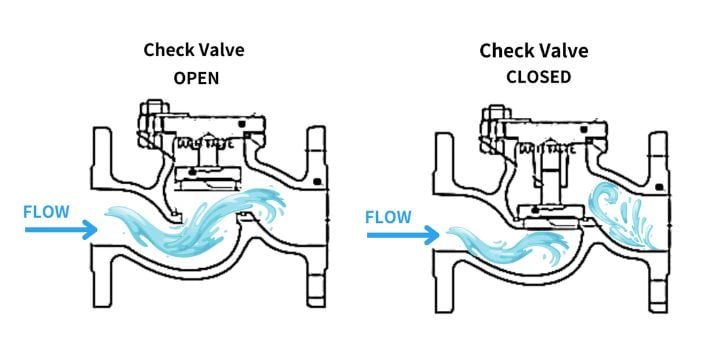
ดังที่แสดงในภาพประกอบ วาล์วกันกลับทำงานดังนี้: แรงดันของของไหลจะดันให้วาล์วเปิด เพื่อให้ของไหลไหลผ่านได้ หากของไหลพยายามไหลย้อนกลับ วาล์วจะปิดทันที และยิ่งแรงดันย้อนกลับมากเท่าใด การซีลก็จะยิ่งแน่นหนามากขึ้น วาล์วกันกลับมักใช้สปริงหรือแรงโน้มถ่วงในการปิด และไม่จำเป็นต้องมีการควบคุมด้วยมือ.
b. วาล์วไดอะแฟรม (Diaphragm Valve)
วาล์วไดอะแฟรมควบคุมการไหลของของไหลโดยใช้ไดอะแฟรมที่ยืดหยุ่นเพื่อปิดกั้นเส้นทางการไหล วาล์วประเภทนี้เหมาะสำหรับการใช้งานที่ต้องการความต้านทานการกัดกร่อน ทำให้เป็นที่นิยมในอุตสาหกรรมเคมีสำหรับจัดการสารเคมี ตัวทำละลาย และสื่อที่มีฤทธิ์กัดกร่อน
วาล์วไดอะแฟรมยังถูกนำมาใช้บ่อยในอุตสาหกรรมอาหารและยา เนื่องจากสามารถป้องกันการปนเปื้อนได้อย่างมีประสิทธิภาพและรับประกันความสะอาดและความปลอดภัยของของไหล.
[4]
| ข้อดี |
ข้อเสีย |
| 1. ความสามารถในการปิดผนึกที่ยอดเยี่ยม |
1. ทนต่อแรงดันได้จำกัด |
| 2. ทนต่อการกัดกร่อนได้ดี เหมาะสำหรับของเหลวที่มีฤทธิ์กัดกร่อน |
2. ไม่เหมาะกับการใช้งานในสภาพแวดล้อมที่มีอุณหภูมิสูง |
| 3. ไม่มีพื้นที่ตาย ลดการสะสมของสารตกค้าง และเหมาะสมกับมาตรฐานด้านสุขอนามัย |
3. มีช่วงการปรับอัตราการไหลที่จำกัด |
[5]
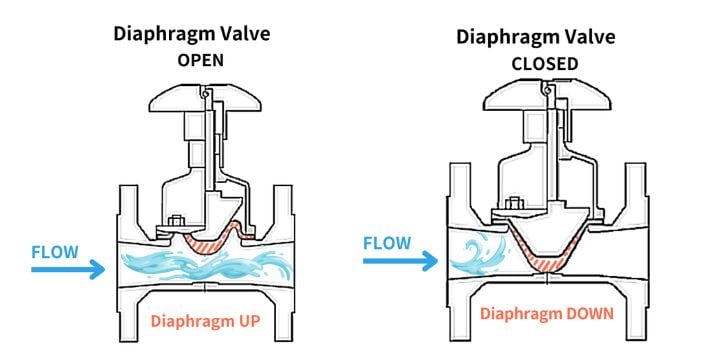
ดังที่แสดงในภาพประกอบ วาล์วไดอะแฟรมประกอบด้วยไดอะแฟรมที่ยืดหยุ่นภายในตัววาล์วและฝาครอบ เมื่อก้านวาล์วยกขึ้น ไดอะแฟรมจะถูกยกขึ้น ทำให้ของไหลสามารถไหลผ่านได้ เมื่อลดก้านวาล์ว ไดอะแฟรมจะกดลงเพื่อปิดทางเข้าและหยุดการไหลของของไหล
การแยกกลไกการทำงานออกจากของไหลโดยใช้ไดอะแฟรมช่วยให้การซีลมีประสิทธิภาพดีเยี่ยม ทำให้วาล์วไดอะแฟรมเหมาะสำหรับของไหลที่มีฤทธิ์กัดกร่อน สลัดกากเส้นใย ของไหลกัมมันตรังสี หรือการใช้งานอื่น ๆ ที่ต้องการการทำงานที่ปราศจากการปนเปื้อน.
c. วาล์วโลก (Globe Valve)
วาล์วโลก หรือที่เรียกว่าวาล์วหยุด (Stop Valve) ใช้สำหรับควบคุมการไหลและแรงดัน และมีความหลากหลายในการใช้งาน เดิมถูกตั้งชื่อตามรูปร่างทรงกลมของตัววาล์ว แต่ปัจจุบันบางครั้งเรียกว่าวาล์วหยุดเพื่อหลีกเลี่ยงความสับสนกับวาล์วลูกบอล (Ball Valve)
วาล์วโลกมักถูกใช้ในระบบแลกเปลี่ยนความร้อน เนื่องจากสามารถให้น้ำไหลตรงผ่านได้โดยตรง ทำให้เหมาะสำหรับของไหลที่มีความหนืดสูง วาล์วประเภทนี้เหมาะสำหรับระบบบำบัดน้ำ สารเคมี ปิโตรเลียม และระบบไอน้ำ เพราะสามารถป้องกันการสะสมและการแข็งตัวของของไหลภายในวาล์วได้.
[6]
| ข้อดี |
ข้อเสีย |
| 1. มีความต้านทานต่ำเนื่องจากเส้นทางการไหลตรง |
1. อุณหภูมิการทำงานจำกัดตามวัสดุของเบาะที่นั่ง |
| 2. มีหลายขนาด เหมาะสำหรับการใช้งานที่หลากหลาย |
2. มีความต้านทานการไหลสูงกว่าวาล์วประเภทอื่น |
| 3. เหมาะสำหรับการใช้งานที่ต้องเปิด-ปิดบ่อยครั้ง |
3. มีน้ำหนักค่อนข้างมาก |
| 4. มีการสูญเสียแรงเสียดทานต่ำ ช่วยยืดอายุการใช้งาน |
|
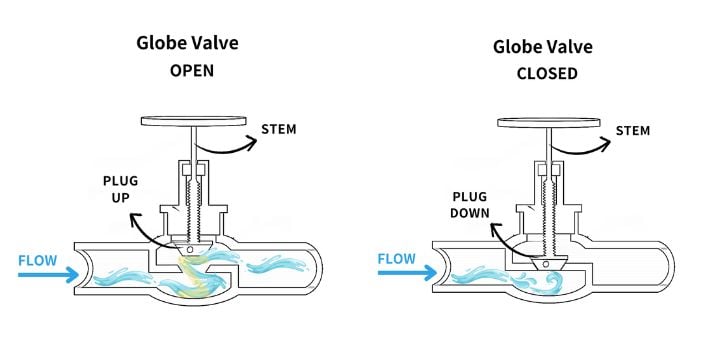
Operation is as follows: turning the handwheel raises the valve stem. When the ball valve opens, the core moves up, allowing fluid to pass. The fluid follows a mirrored Z-shaped path inside the valve, entering low and exiting high, which increases resistance and reduces pressure. To close the valve, the core descends to tightly contact the valve seat, forming a seal to stop fluid flow.
In operation, fluid flows directly from the inlet to the outlet. This linear flow path reduces vortices and stagnation within the valve, helping to prevent high-viscosity fluids from solidifying or accumulating. Ball valves are commonly used in water treatment systems, chemical and petroleum industries, and steam systems.
[7][8]
d. วาล์วเข็ม (Needle Valve)
วาล์วเข็มมีแกนวาล์วที่มีลักษณะคล้ายเข็มซึ่งพอดีกับเบาะวาล์ว (valve seat) อย่างแม่นยำ ทำให้สามารถควบคุมการไหลของของไหลได้อย่างละเอียดที่แรงดันต่ำ วาล์วเข็มเหมาะสำหรับการใช้งานที่ต้องการอัตราการไหลต่ำหรือคงที่ เช่น ระบบสุญญากาศ การเติมก๊าซในท่อ แก๊สเลเซอร์ และอุปกรณ์ที่คล้ายกัน รวมถึงการควบคุมการไหลของเชื้อเพลิงขณะเดินเบาในคาร์บูเรเตอร์
*เอฟเฟกต์เวอร์เนียร์ในวาล์วเข็ม:
เนื่องจากแกนวาล์วเข็มมีลักษณะเป็นทรงกรวย เมื่อควบคุมการเคลื่อนที่ในแนวแกน (เช่น แกนวาล์วเคลื่อนเข้าและออก) จะเกิดความแตกต่างของเส้นผ่านศูนย์กลางระหว่างแกนวาล์วเข็มกับเบาะวาล์ว เอฟเฟกต์เวอร์เนียร์นี้ ซึ่งเกิดจากการเปลี่ยนแปลงในแนวรัศมีที่น้อยที่สุด เป็นกลไกสำคัญที่ทำให้วาล์วเข็มสามารถควบคุมการไหลได้อย่างแม่นยำ
| ข้อดี |
ข้อเสีย |
| 1. การควบคุมอัตราการไหลขนาดเล็กที่แม่นยำ |
1. ไม่เหมาะสำหรับอัตราการไหลสูง |
| 2. เหมาะสำหรับการทำงานที่มีแรงดันต่ำ |
2. มีการสูญเสียแรงดันสูงกว่า |
| 3. สามารถใช้งานในระบบสุญญากาศได้ |
|
| 4. โครงสร้างกะทัดรัดพร้อมความสามารถในการปิดผนึกที่ดี |
|
[9][10]
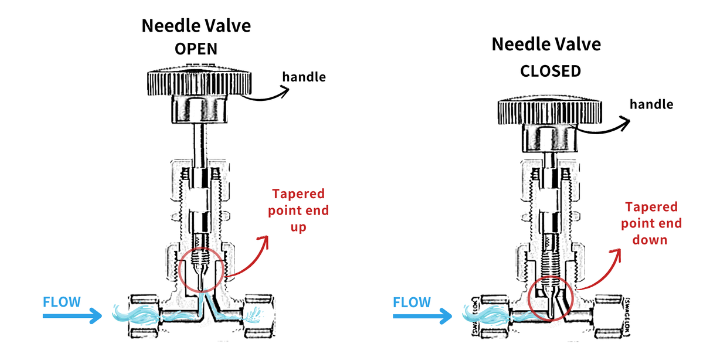
โครงสร้างวาล์วเข็มประกอบด้วยปลายหมุนที่มีแกนคล้ายเข็ม ซึ่งเมื่อปิดแล้วจะพอดีกับเบาะวาล์วอย่างสมบูรณ์ ช่วยให้สามารถควบคุมอัตราการไหลที่ละเอียดมากได้
เนื่องจากข้อจำกัดด้านความสูงของตัววาล์ว ทำให้เกิดการสูญเสียแรงดันของของไหลที่สำคัญ อีกทั้งการใช้ท่อที่แคบยังเพิ่มความเสี่ยงต่อความเสียหายจากของแข็งที่แขวนลอยอยู่ในของไหลอีกด้วย
2 ) วาล์วแบบหมุน (Rotary Motion Valve)
วาล์วแบบหมุนเปิดและปิดโดยการหมุนรอบแกน แกนวาล์ว (valve core) มักทำงานในลักษณะการหมุนเพื่อเปิดหรือปิดเส้นทางการไหลของของไหล
a. วาล์วลูกบอล (Ball Valve)
วาล์วลูกบอลควบคุมการไหลของของไหลโดยใช้ลูกบอลทรงกลมที่มีรูตรงกลาง ลูกบอลนี้สามารถหมุนเพื่อเปิดหรือปิดเส้นทางการไหลได้
วาล์วลูกบอลมีประสิทธิภาพการซีลที่ยอดเยี่ยมและต้องการการบำรุงรักษาเพียงเล็กน้อย การใช้งานที่เรียบง่ายทำให้เหมาะสำหรับการใช้งานที่ต้องการการปิด-เปิดที่รวดเร็วและการซีลที่เชื่อถือได้ วาล์วลูกบอลถูกนำมาใช้อย่างแพร่หลายในหลากหลายพื้นที่ เช่น ท่อส่งน้ำมันและก๊าซในอุตสาหกรรม กระบวนการทางเคมี และระบบน้ำในที่พักอาศัย
[11]
| ข้อดี |
ข้อเสีย |
| 1. รองรับแรงดันและอัตราการไหลสูงได้ดี |
1. มีโอกาสเกิดการสะสมของตะกอนระหว่างลูกบอลและที่นั่ง |
| 2. มีประสิทธิภาพในการซีลที่ยอดเยี่ยม |
2. ต้องการแรงบิดที่สูงขึ้นในการใช้งาน อาจต้องมีระบบช่วยเพิ่มการทำงาน |
| 3. ความต้านทานการไหลต่ำและบำรุงรักษาง่าย |
3. ขนาดโดยรวมใหญ่และมีน้ำหนักมากกว่า |
| 4. สามารถใช้ควบคุมการไหลและเปลี่ยนทิศทางการไหลได้ |
|
[12]
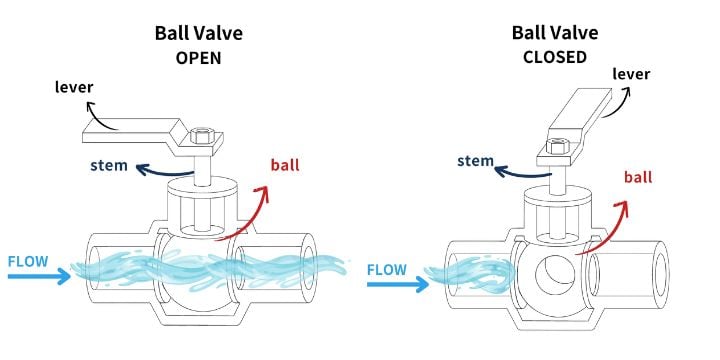
วาล์วลูกบอลมีแกนกลางเป็นลูกบอลกลวงที่มีรูเจาะตรงกลาง ซึ่งมีเส้นผ่านศูนย์กลางเท่ากับท่อที่เชื่อมต่อ
ในการทำงาน ด้ามจับของวาล์วจะหมุนแกนวาล์วเพื่อหมุนแกนลูกบอล เมื่อรูตรงกลางลูกบอลอยู่ในแนวเดียวกับเส้นทางการไหล ของไหลจะสามารถผ่านได้ แต่หากหมุนด้ามจับ 90 องศา รูตรงกลางลูกบอลจะหันออกจากเส้นทางการไหล ทำให้ปิดช่องทางและหยุดการไหลของของไหล
วาล์วลูกบอลมีการใช้งานที่ง่ายและเหมาะสำหรับการควบคุมการไหลที่ต้องการการเปิด-ปิดที่รวดเร็วและมีประสิทธิภาพในการซีลสูง
[13][14]
b. วาล์วผีเสื้อ (Butterfly Valve)
วาล์วผีเสื้อ หรือวาล์วแบบแผ่นปิด มีการออกแบบที่เรียบง่ายและสามารถทำงานได้อย่างรวดเร็วโดยการหมุนแผ่นดิสก์เพื่อควบคุมการไหล เหมาะสำหรับจัดการของเหลวหรือก๊าซปริมาณมากที่แรงดันต่ำ วาล์วชนิดนี้มีความหลากหลายและสามารถใช้งานกับสื่อหลากหลายประเภท เช่น น้ำ น้ำมัน ไอน้ำ และของไหลที่มีฤทธิ์กัดกร่อน การใช้งานทั่วไป ได้แก่ ระบบบำบัดน้ำ อุตสาหกรรมเคมีและปิโตรเคมี ระบบ HVAC และระบบชลประทานทางการเกษตร
วาล์วผีเสื้อมีหลายประเภท ซึ่งแต่ละประเภทเหมาะสำหรับแรงดันและการใช้งานที่แตกต่างกัน:
i. วาล์วผีเสื้อแบบศูนย์กลาง (Concentric butterfly valve): ประเภทนี้ใช้เบาะยางยืดหยุ่นร่วมกับแผ่นดิสก์โลหะ เหมาะสำหรับการใช้งานที่มีแรงดันต่ำที่สุด
ii. วาล์วผีเสื้อแบบเยื้องสองตำแหน่ง (Double-offset butterfly valve หรือ high-performance/double-eccentric): เบาะและแผ่นดิสก์ผลิตจากวัสดุที่แตกต่างกัน ทำให้สามารถใช้งานได้ในช่วงอุณหภูมิและแรงดันที่กว้างขึ้น
iii. วาล์วผีเสื้อแบบเยื้องสามตำแหน่ง (Triple-offset butterfly valve หรือ triple-eccentric): ใช้เบาะโลหะลามิเนตหรือเบาะโลหะแข็ง เหมาะสำหรับระบบแรงดันสูงและสภาพแวดล้อมที่รุนแรง โดยมักใช้ในอุตสาหกรรมและภาคพลังงาน
[15][16]
| ข้อดี |
ข้อเสีย |
| 1. ใช้งานได้รวดเร็ว เหมาะสำหรับการใช้งานบ่อย |
1. การไหลไม่เป็นเส้นตรง ทำให้เกิดแรงดันที่ไม่สม่ำเสมอ |
| 2. มีขนาดกะทัดรัด น้ำหนักเบา และใช้งานง่าย |
2. ประสิทธิภาพการซีลต่ำกว่า |
| 3. ควบคุมการไหลได้ดี |
3. อาจเกิดการสั่นสะเทือนหรือเสียงดังเมื่อใช้งานที่ความเร็วสูง |
| 4. การลดแรงดันต่ำเมื่อเปิดเต็มที่ |
4. ไม่เหมาะสำหรับอุณหภูมิที่สูงมากหรือสภาวะที่มีแรงดันสูง |
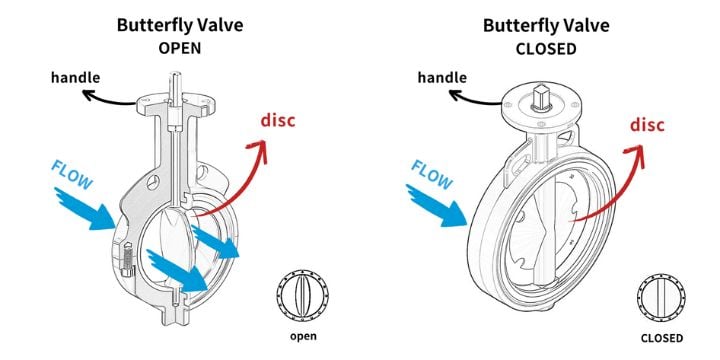
ตามที่แสดง วาล์วผีเสื้อประกอบด้วยแผ่นดิสก์หมุนซึ่งมักอยู่ที่กึ่งกลางของตัววาล์ว ระหว่างการทำงาน แผ่นดิสก์ทรงกลมจะหมุนรอบแกนโดยมีมุมสูงสุด 90 องศา เพื่อปรับการไหลของของไหลโดยการเปลี่ยนมุมของแผ่นดิสก์ เนื่องจากแผ่นดิสก์ยังคงอยู่ในของไหลตลอดเวลา จึงเพิ่มแรงต้านการไหล ทำให้เกิดการสูญเสียแรงดันในบริเวณนั้น
c. วาล์วลดแรงดัน (Pressure Reducing Valve)
วาล์วลดแรงดันเป็นวาล์วนิรภัยที่ใช้ควบคุมหรือจำกัดแรงดันในระบบ เพื่อป้องกันความเสียหายของอุปกรณ์ การระเบิด หรือการเกิดไฟไหม้เนื่องจากแรงดันที่มากเกินไป การทำงานของวาล์วนี้ขึ้นอยู่กับสปริงหรืออุปกรณ์ปรับแรงดันภายในวาล์วที่ควบคุมการเปิดและปิด วาล์วนิรภัยนี้จะเปิดโดยอัตโนมัติเมื่อแรงดันถึงค่าที่ตั้งไว้ เพื่อปล่อยแรงดันส่วนเกินออก
วาล์วลดแรงดันมีความสำคัญอย่างยิ่งในงานอุตสาหกรรม โดยเฉพาะในกระบวนการที่เกี่ยวข้องกับแรงดันสูง เพื่อให้มั่นใจในความปลอดภัยของระบบและการทำงานของอุตสาหกรรม
วาล์วระบายแรงดันถูกออกแบบมาให้มีแรงดันที่ตั้งค่าไว้ล่วงหน้า ซึ่งจะเปิดโดยอัตโนมัติเมื่อแรงดันในระบบถึงระดับที่กำหนด โดยการตั้งค่านี้มักถูกควบคุมด้วยสปริงวาล์วหรือองค์ประกอบเชิงกลอื่นๆ เช่น ตุ้มน้ำหนักหรือวาล์วนำร่อง
ในแผนภาพแสดงวาล์วระบายแรงดันแบบสปริง เมื่อแรงดันในระบบเกินค่าที่ตั้งไว้ แรงดันที่เพิ่มขึ้นจะดันแกนวาล์วให้เคลื่อนที่ไป พร้อมกับบีบอัดสปริงและเปิดวาล์ว จากนั้นจะปล่อยแรงดันหรือของไหลส่วนเกินออกเพื่อลดแรงดันในระบบ เมื่อแรงดันกลับมาอยู่ในช่วงที่ปลอดภัย สปริงจะดันแกนวาล์วกลับสู่ตำแหน่งเดิมและปิดวาล์วอีกครั้ง
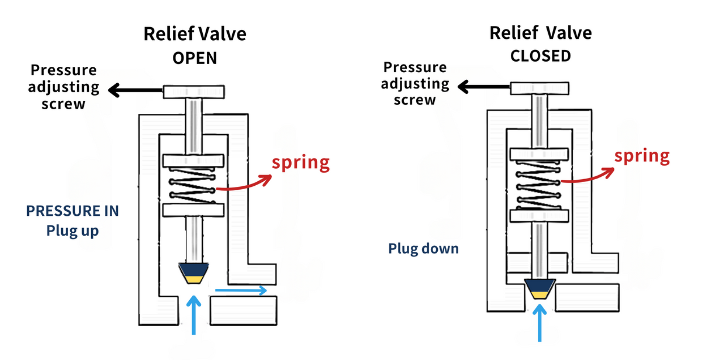
d. วาล์วประตู (Gate Valve)
วาล์วประตูใช้แผ่นประตูที่สามารถเคลื่อนที่ได้เพื่อหยุดหรือเปิดการไหล แต่ไม่เหมาะสำหรับการควบคุมอัตราการไหล วาล์วประเภทนี้มีความต้านทานการไหลต่ำเมื่อเปิดเต็มที่ และต้องการแรงในการใช้งานเพียงเล็กน้อย อย่างไรก็ตาม วาล์วประตูต้องใช้เวลานานกว่าในการเปิดหรือปิดเต็มที่ เนื่องจากระยะการเคลื่อนที่ของแผ่นประตูที่ยาว
[17]
| ข้อดี |
ข้อเสีย |
| 1. มีความสามารถในการปิดการไหลของของไหลอย่างดีเยี่ยม |
1. ความต่างของแรงดันสูงอาจทำให้เกิดการกระแทกของน้ำ (Water Hammer) |
| 2. มีแรงต้านการไหลเกือบเป็นศูนย์เมื่อเปิดเต็มที่ |
2. ใช้เวลานานในการเปิดหรือปิด |
| 3. เหมาะสำหรับของไหลหลายประเภท เช่น ของเหลว ก๊าซ และไอน้ำ |
3. มีขนาดใหญ่ ต้องการพื้นที่มากขึ้น |
| 4. สามารถทนต่อแรงดันและอุณหภูมิสูงได้ |
|
[18]
วาล์วประตูมีหลายประเภท โดยทั่วไปมีโครงสร้างที่เรียบง่ายและไม่มีข้อกำหนดเฉพาะสำหรับการติดตั้งทางเข้าและทางออก ตามที่แสดงในภาพ วาล์วประตูมีแกนที่ยกขึ้นได้ซึ่งควบคุมโดยล้อหมุน (handwheel) หรือมอเตอร์ โดยแกนนี้จะยกแผ่นประตูขึ้นเพื่อเปิดเส้นทางการไหล
วาล์วประตูเหมาะสำหรับท่อที่มีเส้นผ่านศูนย์กลางใหญ่ อย่างไรก็ตาม เนื่องจากอาจเกิดช่องว่างหรือการสึกหรอระหว่างวาล์วและพื้นผิวซีล อาจเกิดการรั่วไหลเล็กน้อยแม้ว่าวาล์วจะปิดสนิทแล้ว สำหรับการใช้งานที่ต้องการการซีลของของไหลอย่างเข้มงวด อาจจำเป็นต้องมีมาตรการเพิ่มเติม
3) วาล์วแบบหมุนหนึ่งในสี่ (Quarter-turn Valve)
วาล์วหมุนแบบมุมฉากทำงานโดยการหมุนแกนวาล์ว 90 องศา ซึ่งแกนวาล์วจะเคลื่อนที่ในแนวนอนหรือแนวตั้งเพื่อเปิดหรือปิดเส้นทางการไหล วาล์วประเภทนี้เหมาะสำหรับการใช้งานที่ต้องการการเปิด-ปิดที่รวดเร็ว และมักถูกใช้งานในระบบควบคุมระยะไกลและระบบอัตโนมัติ
a. วาล์วโซลินอยด์ (Solenoid Valve)
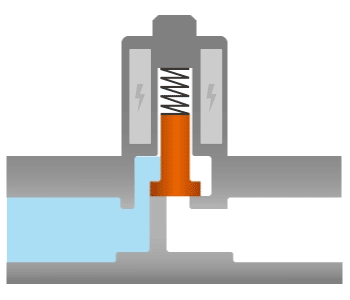
วาล์วโซลินอยด์ทำงานโดยการใช้กระแสไฟฟ้าผ่านขดลวดเพื่อสร้างสนามแม่เหล็ก ซึ่งจะควบคุมการทำงานของวาล์ว วาล์วประเภทนี้ช่วยให้สามารถควบคุมอัตโนมัติและระยะไกลได้ ทำให้เหมาะสำหรับการใช้งาน เช่น การควบคุมเปิด-ปิด ระบบทดสอบในโรงงาน และระบบควบคุมกระบวนการ วาล์วโซลินอยด์ยังถูกใช้งานในแม่แรงไฮดรอลิกและกระบอกไฮดรอลิกของรถบรรทุกอีกด้วย
[19][20]
| ข้อดี |
ข้อเสีย |
| 1. ควบคุมจากระยะไกลและรวดเร็ว เหมาะสำหรับระบบอัตโนมัติ |
1. ใช้ได้เฉพาะของไหลที่สะอาด ไม่เหมาะสำหรับของไหลที่มีความหนืดหรือมีอนุภาค |
| 2. มีขนาดกะทัดรัด ประหยัดพื้นที่ และติดตั้งง่าย |
2. ทนต่อแรงดันได้ต่ำ |
| 3. ใช้พลังงานต่ำ |
3. ต้องการพลังงานที่เสถียร ไม่สามารถทำงานได้เมื่อไฟดับ |
| 4. ควบคุมทิศทางและอัตราการไหลได้อย่างแม่นยำ |
4. ต้องบำรุงรักษาเป็นประจำ เช่น ซีลและขดลวด |
ในวาล์วโซลินอยด์แบบปกติปิด (Normally Closed - NC) วาล์วจะอยู่ในสถานะปิดเมื่อไม่ได้จ่ายกระแสไฟฟ้า ภายในวาล์วโซลินอยด์แบบ NC มีอาร์มาเจอร์ (armature) ที่ล้อมรอบด้วยขดลวดโซลินอยด์ และมีสปริงเชื่อมต่ออาร์มาเจอร์กับลูกสูบ (plunger)
เมื่อไม่ได้จ่ายกระแสไฟฟ้า ลูกสูบจะปิดกั้นเส้นทางการไหลของของไหล แต่เมื่อจ่ายกระแสไฟฟ้า สนามแม่เหล็กจะถูกสร้างขึ้นภายในวาล์วโซลินอยด์ ทำให้ดึงลูกสูบขึ้นและเปิดเส้นทางการไหลของของไหล เมื่อหยุดจ่ายกระแสไฟฟ้า ลูกสูบจะกลับสู่ตำแหน่งเดิมโดยแรงดันของสปริง ทำให้ปิดกั้นการไหลของของไหลอีกครั้ง
[21]
b. วาล์วนิวเมติก (Pneumatic Valve)
วาล์วนิวเมติก หรือวาล์วที่ทำงานด้วยแรงดันลม ใช้แรงดันอากาศในการควบคุมการไหลของของไหล เหมาะสำหรับการใช้งานในสภาพแรงดันสูงและอุณหภูมิสูง โดยมักถูกใช้ในภาคพลังงานสำหรับการควบคุมน้ำมัน ก๊าซ และน้ำ ในอุตสาหกรรมเคมีสำหรับถังปฏิกรณ์และถังเก็บ รวมถึงในอุปกรณ์ทางการแพทย์ เช่น เครื่องช่วยหายใจและระบบจ่ายก๊าซ
หลักการทำงานของวาล์วนิวเมติกนั้นเรียบง่าย: วาล์วจะเปิดเมื่อไม่มีลม และปิดเมื่อมีลม
[22]
| ข้อดี |
ข้อเสีย |
| 1. ปลอดภัยสูง ใช้งานได้ในสภาพแวดล้อมที่รุนแรง |
1. ต้องใช้ระบบอัดอากาศ มีค่าใช้จ่ายติดตั้งเริ่มต้นสูง |
| 2. เปิด/ปิดรวดเร็ว เหมาะสำหรับงานที่ต้องการการตอบสนองเร็ว |
2. ต้องมีอุปกรณ์กรองและทำให้อากาศแห้งเพื่อปกป้องส่วนประกอบ |
| 3. มีแรงขับเคลื่อนสูง เหมาะสำหรับวาล์วขนาดใหญ่และระบบแรงดันสูง |
3. ความแม่นยำในการควบคุมจำกัด ไม่เหมาะสำหรับการควบคุมอัตราการไหลที่ต้องการความละเอียด |
| 4. การออกแบบเรียบง่ายและทนทาน เหมาะสำหรับการใช้งานบ่อย |
4. อาจเกิดเสียงดังระหว่างการปล่อยไอเสีย |
วาล์วนิวเมติก หรือวาล์วที่ทำงานด้วยแรงดันลม ใช้แรงดันอากาศในการควบคุมการไหลของของไหล เหมาะสำหรับการใช้งานในสภาพแรงดันสูงและอุณหภูมิสูง โดยมักถูกใช้ในภาคพลังงานสำหรับการควบคุมน้ำมัน ก๊าซ และน้ำ ในอุตสาหกรรมเคมีสำหรับถังปฏิกรณ์และถังเก็บ รวมถึงในอุปกรณ์ทางการแพทย์ เช่น เครื่องช่วยหายใจและระบบจ่ายก๊าซ
หลักการทำงานของวาล์วนิวเมติกนั้นเรียบง่าย: วาล์วจะเปิดเมื่อไม่มีลม และปิดเมื่อมีลม
[23][24]
4. คำแนะนำเกี่ยวกับวาล์ว - KOSCN ผู้เชี่ยวชาญด้านวาล์วควบคุมของไหล
KOSCN เป็นบริษัทผู้ผลิตผลิตภัณฑ์ควบคุมของไหลระดับสากล ตั้งแต่ปี 2005 บริษัทได้พัฒนาสิทธิบัตรหลายรายการสำหรับผลิตภัณฑ์วาล์วควบคุมอัตโนมัติผ่านเทคโนโลยีระดับมืออาชีพ ตั้งแต่การวิจัยและพัฒนาไปจนถึงการออกแบบ เครือข่ายการขายของบริษัทครอบคลุมจากสำนักงานใหญ่ในประเทศจีนไปยังผู้จัดจำหน่ายในต่างประเทศ
วาล์วไดอะแฟรมไฟฟ้า KOSCN Scientific รุ่น MV304
วาล์วควบคุมรุ่น MV ของ KOSCN มาพร้อมกับการออกแบบภายนอกที่ทำจากพลาสติกทั้งหมด การออกแบบทางเดินของไหลที่เรียบช่วยเพิ่มความจุการไหลให้สูงกว่าผลิตภัณฑ์มาตรฐาน รุ่นนี้มีตัวเลือกการควบคุมทั้งแบบแมนนวล นิวเมติก และไฟฟ้า เพื่อตอบสนองความต้องการที่หลากหลายของลูกค้า นอกจากนี้ ผลิตภัณฑ์ยังสอดคล้องกับขนาดการติดตั้งมาตรฐานสากล และรองรับการแสดงสถานะตำแหน่งและโมดูลควบคุมแบบสัดส่วน (Proportional Control Module)
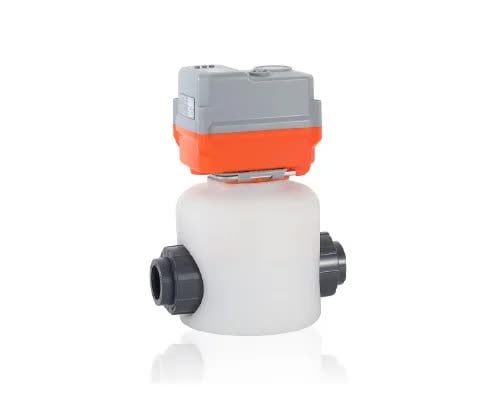
วาล์วไดอะแฟรมไฟฟ้า MV304 มาพร้อมกับการติดตั้งและบำรุงรักษาที่ง่ายดาย รวมถึงความปลอดภัยสูง โมดูลอัตโนมัติใช้การเชื่อมต่อแบบหนีบ (Clamp-type) ทำให้การประกอบและถอดออกเป็นไปอย่างสะดวก อินเทอร์เฟซ LED ช่วยให้ผู้ใช้งานสามารถตั้งค่าและตรวจสอบได้ง่าย นอกจากนี้ แรงบิดของผลิตภัณฑ์ KOSCN ยังได้รับการตรวจสอบอย่างอิสระเพื่อรับรองอายุการใช้งานที่ยาวนาน ประเภทการเชื่อมต่อมีทั้งแบบ Socket Weld, Butt Weld และอินเทอร์เฟซมาตรฐานอื่น ๆ อีกมากมาย รองรับช่วงสัญญาณหลากหลาย เช่น 4-20mA, 0-20mA, 0-5V, 1-5V และ 2-10V ทำให้เป็นวาล์วอัตโนมัติที่ยอดเยี่ยมและมีประสิทธิภาพการควบคุมที่เหนือกว่า
วาล์วบอลลม KOSCN BV202
วาล์วบอลพลาสติกรุ่น BV ของ KOSCN เป็นผลิตภัณฑ์มาตรฐานที่มาพร้อมการออกแบบโครงสร้างที่สอดคล้องกับมาตรฐานสากล โดยมีความจุการไหลสูงและแรงบิดต่ำ รองรับการขยายโมดูลเพื่อควบคุมด้วยไฟฟ้าและลม ช่วยเพิ่มความสามารถในการใช้งานอัจฉริยะ นอกจากนี้ ยังมอบฟังก์ชันหลากหลาย เช่น การควบคุมเปิด/ปิด การปรับอัตราการไหล การแสดงผลสถานะสัญญาณ การรีเซ็ตอัตโนมัติ และสัญญาณเตือนข้อผิดพลาด
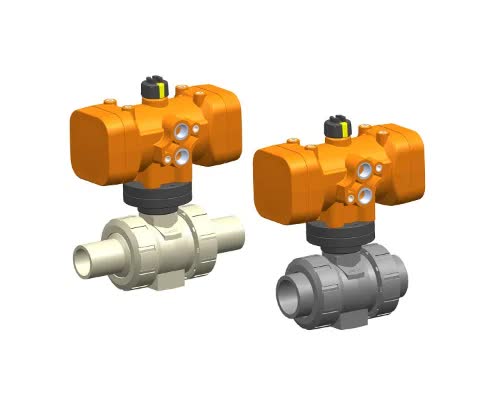
KOSCN BV202-PRO วาล์วลูกบอลนิวเมติก เป็นผลิตภัณฑ์สำหรับงานเคมีที่มีโครงสร้างพลาสติกเต็มรูปแบบ น้ำหนักเบา ทนต่อการกัดกร่อน และมาพร้อมกับฟังก์ชันต่างๆ เช่น การเปิด-ปิด การควบคุม การส่งสัญญาณกลับ การรีเซ็ตอัตโนมัติ และการเตือนข้อผิดพลาด BV ซีรีส์มาพร้อมกับสวิตช์ส่งสัญญาณตำแหน่งและอินเทอร์เฟซโมดูลขยายสำหรับตัวกำหนดตำแหน่ง ช่วยให้การติดตั้งและการใช้งานเป็นไปอย่างง่ายดาย เพื่อความปลอดภัย วาล์วนี้มีการออกแบบเผื่อแรงดันเกินและใช้เกลียวทรงสี่เหลี่ยมคางหมูสำหรับน็อตล็อคเพื่อป้องกันการหลุดออก ทำให้เป็นวาล์วลูกบอลที่ปลอดภัยและใช้งานง่าย
⮕ KOSCN มีวาล์วหลากหลายประเภท:
วาล์ว KOSCN